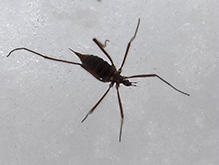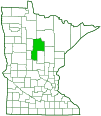Snow fly
(Chionea valga)
Conservation • Description • Habitat • Ecology • Distribution • Taxonomy
Conservation Status |
|||
| IUCN Red List | not listed |
||
| NatureServe | not listed |
||
| Minnesota | not listed |
||
Description
Snow fly is a small, wingless, limoniid crane fly. It occurs in North America mostly from Nova Scotia to Ontario, south to Massachusetts and Minnesota, with outlying records in Alberta and Virginia. It is found in woodlands from September through May, but is most active in October to November and February to March. Though believed to be common, it is rarely seen due to its unusual habits. It lives on the ground. It is most often seen on sunny winter days walking on snow near a tree trunk or stone that is warmed by the sun, thus creating an opening in the snow where the insect can emerge.
Snow fly was originally described in by its discoverer 1841. Few other descriptions of it can be found. Adults are brownish-yellow and ⅛″ to 3 ⁄16″ (3.5 to 5 mm) long, not including the legs. They look more like spiders than flies.
The head is small and hairy. The antennae have 7 or 8 segments. The first two segments are thick. The remaining segments are slender and are covered with hairs.
There are no wings but there is a pair of yellow balancing organs (posiers) at the rear part of the thorax. The female has a long, sword-shaped “borer” at the end of the abdomen. The male has a pair of large claspers at the end of the abdomen.
The legs are long and somewhat paler than the body. They are covered with short hairs. On males the third segment (femur) of the hind leg is thickened.
Size
Body length: ⅛″ to 3 ⁄16″ (3.5 to 5 mm)
Similar Species
Habitat
Woodlands
Ecology
Season
September through May
Behavior
Life Cycle
The female uses its borer to deposit eggs into the ground.
Larva Food/Hosts
Adult Food
Distribution |
||
|
Sources |
|
| 10/4/2025 | ||
Occurrence |
||
Though believed to be common, there are relatively few records of snow fly since its discovery in 1841. |
||
Taxonomy
Order
Suborder
Nematocera
Infraorder
Tipulomorpha (crane flies)
Superfamily
Tipuloidea (typical crane flies)
Family
Limoniidae (limoniid crane flies)
Subfamily
Chioneinae
Tribe
Eriopterini
Genus
Chionea (snow flies)
Subgenus
Chionea
Subordinate Taxa
Synonyms
Chionea aspera
Chionea gracilis
Chionea noveboracensis
Chionea waughi
Common Names
This species group has no common name. The common name of the genus Chrysoperla is common green lacewings, and it is applied here for convenience.
Glossary
Femur
On insects and arachnids, the third, largest, most robust segment of the leg, coming immediately before the tibia. On humans, the thigh bone.
Visitor Photos
Share your photo of this insect.
This button not working for you?
Simply email us at info@MinnesotaSeasons.com.
Attach one or more photos and, if you like, a caption.
Luciearl |
 |
It warmed up into the mid 30's today. As we walked through the deep snow we often found what looked to be fleas in the animal tracks. After observing this over and over we came to a hole in the snow with a spider crawling out of it. It was eating the pinpoint size 'fleas'. |
MinnesotaSeasons.com Photos
|

Slideshows

Visitor Videos
Share your video of this insect.
This button not working for you?
Simply email us at info@MinnesotaSeasons.com.
Attach a video, a YouTube link, or a cloud storage link.
Other Videos
Snow fly
penguinpouf

Visitor Sightings
Report a sighting of this insect.
This button not working for you?
Simply email us at info@MinnesotaSeasons.com.
Be sure to include a location.
Luciearl
12/22/2019
Location: Fairview Twp, Cass County
It warmed up into the mid 30's today. As we walked through the deep snow we often found what looked to be fleas in the animal tracks. After observing this over and over we came to a hole in the snow with a spider crawling out of it. It was eating the pinpoint size 'fleas'.
MinnesotaSeasons.com Sightings


